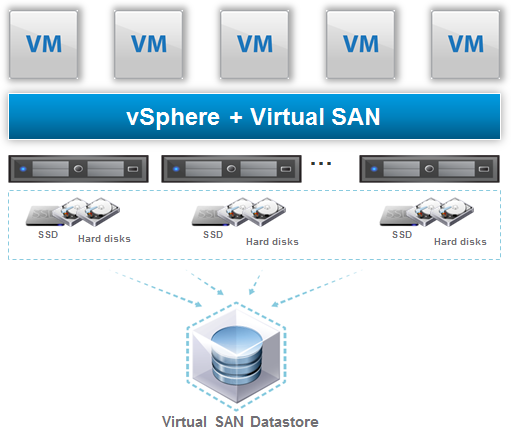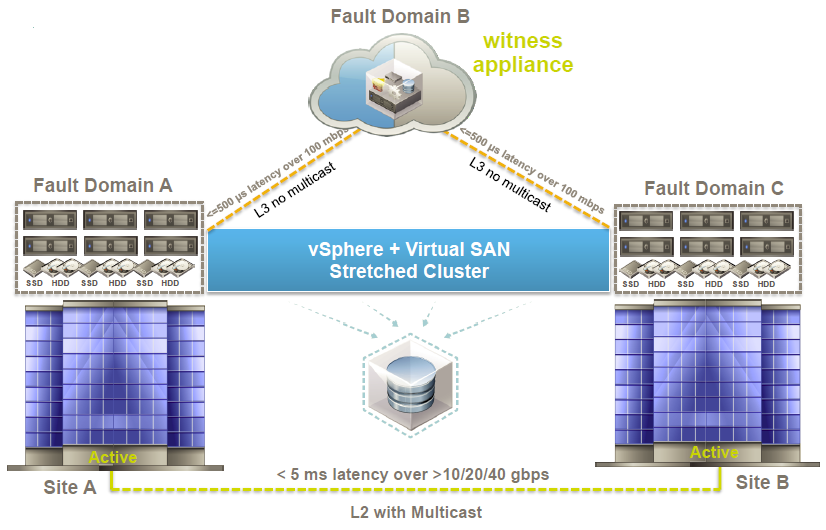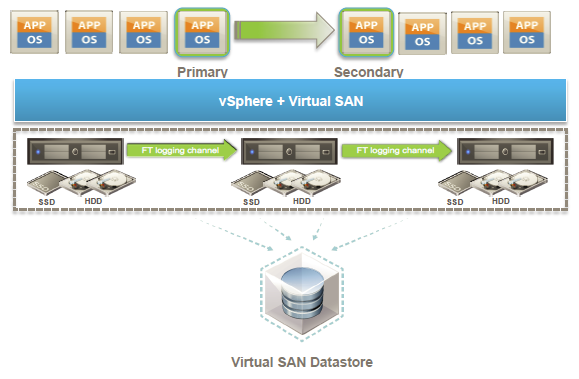VMware Virtual SAN 6.0 (formally was v2.0) was a big improvement of the VMware’s hyperconverged storage solution with some important new features like the new filesystem (with powerful snapshot implementation), the concept of fault domain (to improve data resiliency), more scalability and the full flash option.
Now VMware has announced a new release: Virtual SAN (or VSAN) 6.1, with new improvements, including enhanced usability & management, advanced troubleshooting, and several new features.
Virtual SAN and Stretched Cluster
This is a new feature and a new deployment scenario with two different sites but a single VMware vSphere cluster and a single Virtual SAN storage spanned on the two different sites. This concept is not new at all (also called metro-cluster or campus-cluster) and it’s really interesting as an alternative to traditional disaster recovery site approach.
The stretched cluster implementation of VSAN has several advantages:
- Increases Enterprise availability and data protection
- Deploy Virtual SAN between geographically dispersed locations
- Based on an Active–Active architecture
- Supported on both Hybrid and All-Flash architectures
- Enables synchronous replication of data between sites
- Site failure tolerated, with no data loss and near zero downtime
Stretched Cluster is based on Virtual SAN’s Fault Domain architecture with three different fault domain: A and C for the two site and B as a witness. Witness is responsible for quorum and voting mechanism during cluster related failures and is needed to avoid the split brain scenario. Witness only stores meta-data, does not have any running VMs.
Witness is an ESXi virtual appliance and can be deployed onto a 3rd site or it can be hosted on vCloud Air (this second option is the most interesting).
– Stretched cluster introduces fault domain/site Read Locality
Virtual SAN and Asyncronous Replication
Another important news is the compatibility between Virtual SAN (also with Stretch Cluster scenario) with vCloud Air Disaster Recovery.
But also an enhanced Replication with vSphere Replication (VR) and SRM:
- Replication between Virtual SAN datastores enables RPOs as low as 5 minute
- 5 minutes RPO is exclusively available to Virtual SAN 6.x
- Lower RPO’s are achievable due to Virtual SAN’s efficient vsanSparse snapshot mechanism
Virtual SAN and VMware FT
Previous version of Virtual SAN where not compatible with VMware FT, now with VSAN 6.1 is possible use the new SMP-FT introduced in vSphere 6.0:
VMware FT is a continuous availability in order to protect latency sensitive applications from failures:
- RPO/RTO=0 – no loss of TCP connections
- FT creates a second copy of VMDKs
- Can be located on separate fault domains for further isolation (not stretched clusters)
Virtual SAN and guest cluster
Another limit of previous version of VSAN has gone: now it’s possible have a guest cluster running on a VSAN datastore. And Oracle Real Application Cluster (RAC) it’s supported!
For Microsoft Windows Server Failover Cluster are supported:
- Exchange Data Availability Groups (DAG) with file share witness quorum ONLY
- SQL Server AlwaysOn Availability Group (AAG) with file share witness quorum ONLY





